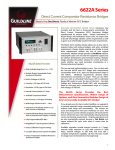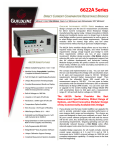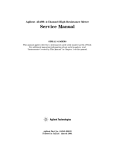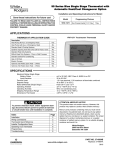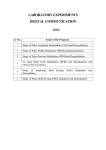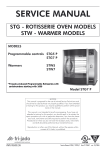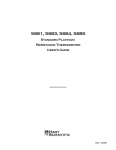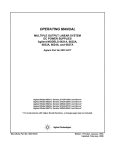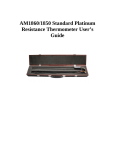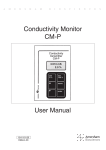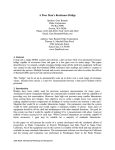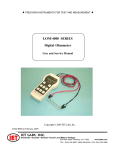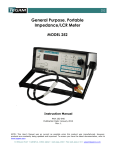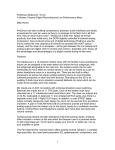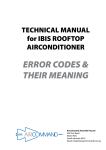Download 6622T Datasheet - Guildline Instruments
Transcript
Model 6622T Series DCC Thermometry Bridges Accurate WIDE RANGE DCC Thermometry Bridges GUILDLINE INSTRUMENTS MODEL 6622T THERMOMETRY Bridge Series expands upon the success of 6622A Series Resistance Bridges by utilizing engineering ingenuity to offer leading uncertainties and stabilities for Temperature Bridges. This design introduces unique innovations in hardware and software for a wide range Thermometry Bridge Series accommodating SPRT’s, PRT’s, various RTD’s, and thermistors. The measurement range of the 6622T Series is from 0.1 Ω to 100 kΩ. 6622T SERIES FEATURES ♦ Accuracy to 0.025 mK (i.e. best uncertainty at 0.1 ppm) ♦ Extended Performance (XP) Model Provides Best Accuracy at 0.013 mK (i.e. best uncertainty at 0.05 ppm) ♦ Wide Range From 0.1 Ω ~ 100 kΩ, Supporting a Wide Variety of SPRT’s, PRT’s, RTD’s Including Ruthenium Oxide RTD’s Used In Cryogenic Applications ♦ Built in Temperature Conversion for ITS-90 and IPTS-68 ♦ Optimized for Operation at Low Power Levels and Higher Speeds ♦ Optional Thermometry Adaptor with Programmable Pre-Heat and Full Automation Capability ♦ Graphical and Statistical Display ♦ Resolution: ± 0.001 ppm of Full Scale ♦ Linearity: ± 0.01 ppm of Full Scale ♦ Wide Range of Ratios: 0.1:1 ~ 100:1 ♦ Fully Programmable IEEE 488.2 ♦ BridgeWorksTM Data Acquisition Software ♦ Unique Calibration Support Strategy ♦ Complete Measurement Systems Available ♦ Optional Internal Resistance Calibration There are two models in the 6622T Thermometry Bridge Series providing increasing levels of accurary and are well suited for temperature calibration and research. The use of a DCC bridge in thermometry is beneficial as it has inherently better noise immunity to external electromagnetic noise and mechanical disturbance. One of the key features of Guildline’s Thermometry bridges is that they are verified at the lower currents found in thermometry. The 6622T Provides the Widest Range of Temperature Measurement of Any Commercially Available Temperature Bridge Today! 6622T Series Measurements are conducted in true fourterminal mode so long test leads can be used. Since excitation current is DC, reactance introduced by the probe and probe leads does not affect measurement accuracy. Thermal EMF is eliminated by periodic polarity reversal that is programmable by the user. The built-in, extremely stable current supply permits selection of output currents between 20 µA and 150 mA to satisfy a wide range of sensitivity requirements. To account for self heating of an SPRT, Root 2 value current can be conveniently chosen from the instrument front panel or via software. The 6622T Thermometry Bridge Series has an intuitive internal menu system that addresses temperature requirements without the need for external software or manual calculations. The calculation and temperature conversions are done internally via firmware and the results are viewed graphically via the front panel in resistance ratio, Ω, °C, °F, and °K. The Bridge menu supports various temperature scales such as the ITS-90, the IPTS-68 and IEC751. This easy-to-use front panel greatly reduces an operator’s learning curve. An IEEE 488.2 communication port is a standard configuration, allowing computerized operation. 1 6622T DCC Thermometry Bridge Series Design and Innovation See what you have been missing! The on screen graphical display and associated data buffers can visually track temperature and the realization of fixed points! The 6622T is the only thermometry bridge available with this on-instrument data and graphics capability, which greatly simplifies tracking temperature changes and monitoring fixed point realization. The comprehensive menu allows users to view the measurement data in either graphical or text format. The last 1000 entries are kept in the 6622T’s memory and individual entries can be examined. A user can either view the present measurement result, a Summary detailing the Minimum, Maximum, Average, Standard Deviation, or the Graphic Trace of the measurement. Every effort has been taken in the 6622T Thermometry Bridge design to reduce noise and error. Thermal EMF effects are eliminated by automatic current reversal. DC Bridges, like the 6622T, have inherently better immunity to external electromagnetic and mechanical noise relative to AC Bridges. This is based on the underlying direct current comparator technology used for DC Bridges which is not subject to switch contact and other parasitic resistances, nor capacitance or inductance effects on the internal measurement components and connection leads. The unique architecture of the 6622T Bridge and a control algorithm further removes gain and offset errors in the nanovolt balance detector and the precision toroid. The end results are shown by long term accuracy and linearity without the need for routine, frequent calibrations. Measurements are conducted in true four-terminal mode so long test leads can be used. Since excitation current is DC, reactance introduced by the probe and probe leads does not affect measurement accuracy. Immunity to noise is very important because of the electromagnetic noise generated by furnaces and baths that are present in Thermometry Laboratories. Finally DC Bridges are not susceptible to temperature variations or warm up times. The result is that 6622T DC Thermometry Bridges have much better stability and noise resistance than AC temperature Bridges, such as those provided by ASL. The model 6622T thermometry bridge can be used in either a fixed or dynamic reversal rate mode of operation. In fixed reversal rate mode, automatic current polarity reversal is user programmable from 4 seconds to 27 minutes with two measurements per reversal. Dynamic reversal rate mode is only available in computerized measurements, where the bridge software optimizes the polarity reversal rate in real time. In temperature applications, this feature makes it easy to track a fast changing temperature. Guildline’s 6622T Bridge can make measurements every two seconds, which eliminates any concerns that DC Bridges are slower than AC Bridges. This measurement time is more than fast enough to track temperature changes. In fact a two second measurement rate is much faster than the time required for PRTs and Fixed Points to stabilize. Two Internal Buffers are used by the 6622T Series for Temperature Measurements. The 6622T Series of Bridges incorporates two independent buffers which dramatically improves thermometry measurements by giving a customer the tools to make educated choices and obtain optimum results. When making a measurement the 6622T will begin to collect data in both a Summary and a Detail buffer. By watching the summary buffer or graphics display a metrologist can visually see a temperature measurement settle into plateau. Once into plateau a user can switch over to the summary data screen and see a statistical analysis of both the Summary and the Detail buffers which includes the mean and the standard deviation. At this point both the summary and detail buffers have identical information. However now that the test is settled you can clear the Detail buffer and let it build up a new data set that contains only information taken at the plateau level. This will give you a new average, standard deviation, and graphical view of your measurement, which can be used for your official reported reading. Meanwhile all the information on the full test realizing the plateau is still retained in the Summary buffer and on a computer, if connected. Both buffers can be independently cleared at any time and come with their own graph. The individual points can be viewed in the detail buffer and captured to a computer over the remote interface. The statistical analysis of both buffers can be viewed in the summary screen. This analysis provides mean, standard deviation, minimum value, maximum value, and sample counts for both independent buffers. With Guildline’s 6622T Thermometry Bridge, customers only need to deploy and support a ONE-BRIDGE SOLUTION to meet their temperature calibration needs, and optionally their resistance measurement needs. For customers this means a substantial reduction in staff training and capital spending. The flexibility to purchase options and upgrades for the 6622T Bridge means that new calibration procedures can be implemented inexpensively without additional training and support that is required when new calibration instruments are purchased from multiple vendors. 2 6622T DCC Thermometry Bridge Series 6622T Bridgeworks Software Not only does Guildline provide unique features with our DCC Thermometry Bridge hardware, but also we offer complete automation solutions via our software. BridgeWorks can completely automate setup, control, measurements, and measurement reporting and is provided free with each 6622T thermometry bridge. BridgeWorks software is extremely powerful, yet straight forward and user friendly. The software comes with all useful and convenient features found in commonly used window based commercial software programs. On-line context help is available to provide added assistance in understanding the functions of the software. BridgeWorks is developed in LabVIEW© offering direct compatibility with all National Instruments GPIB interfaces. These interfaces come in a wide variety of connection options to your PC such as USB, FireWire, Ethernet, PCI, PCMCIA, RS232/485, and more. Additionally, utilities reside within the software to enhance and simplify the calibration of SPRT’s and PRT’s. When the 6622T Thermometry Bridge is used with Guildline’s unique 3210 Thermometry Auto-Switch with Programmable PreHeat functionality, the software can turn the bridge into a multiple-channel calibration and measurement system. Timed, sequenced or scheduled single or multiple tests can be initiated while the bridge is unattended. All user definable test variables, such as excitation current, reversal rate, etc can be programmed on a per test basis, giving the users full control and flexibility in conducting well designed experiments. For a complete, automated temperature measuring system, a 6622T bridge can be used with Guildline’s 3210 Thermometry Auto-Switch, and Guildline’s 6634A Temperature Stabilized Resistance Standard. BridgeWorks software offers many routine thermometry functions such as SPRT calibrations to ITS-90 scale. It also provides comprehensive graphic display, math functions and trend analysis. Data can be easily exported to MS-Excel®, Crystal Reports® and in HTML format. All reports generated conform to traceability requirements of ISO 17025. The optional 3210 Thermometry Adaptor with pre-heat enables multiple Resistance Temperature Devices to be calibrated at the same time along with providing programmable pre-heat capability. The Guildline SPRT Adaptor is the only scanner/adaptor that can provide programmed pre-heat currents on a per channel basis. Other manufacturers do not have pre-heat capability or only provide a single, fixed, preheat current. The performance of the 6622T Thermometry Bridge is based on over 55 years of innovation, design knowledge, and manufacturing experience that Guildline has in building temperature and resistance measurement instruments. Over 150 of the 6622 Series Bridges and Measurement systems have been sold world-wide in the past ten years. Multi-Ratio Capability is another Key Feature of Guildline’s 6622T Thermometry Bridge Series. This feature is not normally found in temperature Bridges. There are three key benefits to multi-ratio temperature bridges: 1) better uncertainties, 2) fewer reference resistors (as well as using more Decade Values), and 3) customer intermediate verification checks of a bridge’s calibration. Point 1 allows the temperature bridge to measure current changes at the low values typically found with temperature measurements (i.e. 100 Ω PRT at 1 mA), while maintaining the reference resistor at a higher current level (such as a 1Ω Standard at 100 mA). This is important because the reference resistor will have better uncertainties at higher current levels and it is typically calibrated at the higher current level. 3 6622T DCC Thermometry Bridge Series The following Table shows the impact of multi-ratio and the use of decade Resistance Standards (as well as the 25Ω value) for Thermometry Applications. This table provides examples of the temperature ranges that can be supported by a single standard resistor. PROBE TYPE 0.25 Ω HTPRT (Pt) 2.5 Ω HTPRT (Pt) 10 Ω RTD (Cu-10) 25.5 Ω SPRT (Pt) 27 Ω RTD (Rh-Fe) 100 Ω PRT (Pt) 120 Ω RTD (Ni-120) 2252 Ω Thermistor 10 kΩ Thermistor 2.2 kΩ RTD (RuO2) RESISTANCE RANGE Ω TEMPERATURE RANGE K CURRENT MA STANDARD RESISTOR Ω 0.04 - 1.0 0.4 - 10.0 5.1 - 19.2 4 - 100 17 - 75 17 - 340 66 - 381 300 - 7.4k 2.6k - 30k 2.2k - 75k 273 - 1343 273 - 1343 173 - 533 73 - 933 1.4 - 300 73 - 873 193 - 533 273 - 373 273 - 373 0.02 - 4.2 10 3 3 1 1 1 1 0.1 0.03 0.01 1 1 1 (or 10) 10 (or 1, 25) 10 (or 1, 25) 25 (or 10, 100) 25 (or 10, 100) 100 (or 1k) 1k (or 10k) 1k (or 10k) PROBE UNCERTAINTY (23 ± 2°C) XP MODEL MK PPM OF RATIO 0.075 0.013 0.013 0.013 0.013 0.013 0.013 0.050 0.250 0.250 0.3 0.05 0.05 0.05 0.05 0.05 0.05 0.2 1.0 1.0 Verification of Performance Historically the calibration of a precision Thermometry Bridge was challenging. A Harmon type transfer standard was needed for the verification of a bridge’s non 1:1 measurement ratios along with high technical skill levels. With the introduction of the 6622A multi-ratio bridge, a verification of performance relative to the most recent calibration can be carried out with ease. Frequent verification of the bridge performance can also provide insight into the bridge’s short and long-term stability to improve user’s confidence levels and uncertainties. The 1:1 measurement ratio can be easily verified or calibrated by interchange measurement tests using two stable standard resistors of same nominal values, as illustrated by the block diagram to the right. This technique is referred to as ‘selfcalibration’ by competitors and works with all manufacturers’ thermometry bridges. The Thermometry Bridge 1:1 measurement ratio error ei (in ppm) is calculated using the following formula ei = (1/2)· |R1 · R2 -1| ·10 1Ω Ratio R1 6 Non 1:1 measurement ratios, such as 10:1 and 100:1 ratios can be easily verified by closure measurement tests using three stable standard resistors, as illustrated by the block diagram to the right. Bridge non 1:1 measurement ratio error ec (in ppm) is calculated using the following formula ec = (1/3)· |Ra - Rb · Rc| / Ra · 10 1Ω Ratio Rb 1Ω 10 Ω Ratio Rc 6 Note: Resistance values in these block diagrams are only representative values and are selected for the illustration of methodology only. Ratio R2 Ratio Ra 100 Ω This Multi-Ratio capability allows users to extend the calibration interval of the Thermometry Bridge while still maintaining a high level of confidence, thus saving thousands of dollars each year in support of the instrument. With an annual verification, a Guildline 6622T Thermometry Bridge typically can go five years between calibrations. 4 6622T DCC Thermometry Bridge Series 6622T Series Specifications The following tables show the uncertainty contribution of the model 6622T Bridges to the total measurement. Because of the wide range of Rx/Rs ratios available, it is possible to measure UUT’s with a variety of Rs standards. For example, a 100Ω UUT could be measured with a 1 Ω, 10 Ω or 100 Ω reference standard (Rs). To determine the bridge’s contribution to measurement uncertainty, simply look at the Rs you are using, and go to the appropriate UUT range. The base model 6622T Bridge has a best uncertainty of 0.1 ppm, that is equivalent to ±25 µK for a 25.5Ω SPRT at 0 °C measured against a 25Ω reference resistor. The 6622T-XP Bridge has a best uncertainty of 0.05 ppm/±13 µK. R X /R S M E A S U R E M E N T U N C E R T A I N T Y (3 Y E A R S ) Rs 1Ω 0.08Ω ► Rx ◄ 0.8Ω 0.8 Ω ► Rx◄ 6.3Ω 6.3 Ω ► Rx ◄ 13.4Ω 13.4Ω ► Rx ◄ 107.5Ω Base Model ± 0.4 ppm ± 0.1 ppm ± 0.1 ppm ± 0.2 ppm < ± 0.04 ppm XP Model ± 0.3 ppm ± 0.05 ppm ± 0.05 ppm ± 0.1 ppm < ± 0.04 ppm R X /R S M E A S U R E M E N T U N C E R T A I N T Y (3 Y E A R S ) 24 Hour Stability Rs 10 Ω 0.08Ω ► Rx ◄ 0.8Ω 0.8Ω ► Rx ◄ 6.3Ω 6.3Ω ► Rx◄ 13.4Ω 13.4Ω ► Rx ◄ 107.5Ω Base Model ± 0.4 ppm ± 0.1 ppm ± 0.1 ppm ± 0.2 ppm < ± 0.04 ppm XP Model ± 0.3 ppm ± 0.05 ppm ± 0.05 ppm ± 0.1 ppm < ± 0.04 ppm R X /R S M E A S U R E M E N T U N C E R T A I N T Y (3 Y E A R S ) 24 Hour Stability Rs 25 Ω 2.5Ω ► Rx ◄ 20Ω 20Ω ► Rx ◄ 157.5Ω 157.5Ω ► Rx ◄ 335Ω 335Ω ► Rx ◄ 2687Ω Base Model ± 0.4 ppm ± 0.1 ppm ± 0.1 ppm ± 0.2 ppm < ± 0.04 ppm XP Model ± 0.3 ppm ± 0.05 ppm ± 0.05 ppm ± 0.1 ppm < ± 0.04 ppm R X /R S M E A S U R E M E N T U N C E R T A I N T Y (3 Y E A R S ) 24 Hour Stability Rs 100 Ω 10Ω ► Rx ◄ 80Ω 80Ω ► Rx ◄ 630Ω 630Ω ► Rx ◄ 1340Ω 1.34kΩ ► Rx ◄ 10.75kΩ Base Model ± 0.4 ppm ± 0.1 ppm ± 0.1 ppm ± 0.4 ppm < ± 0.04 ppm XP Model ± 0.3 ppm ± 0.05 ppm ± 0.05 ppm ± 0.2 ppm < ± 0.04 ppm R X /R S M E A S U R E M E N T U N C E R T A I N T Y (3 Y E A R S ) 24 Hour Stability Rs 1 kΩ 100Ω ► Rx ◄ 800Ω 800Ω ► Rx ◄ 6.3 kΩ Base Model ± 0.4 ppm ± 0.1 ppm ± 0.1 ppm ± 1.0 ppm < ± 0.04 ppm XP Model ± 0.3 ppm ± 0.1 ppm ± 0.1 ppm ± 1.0 ppm < ± 0.04 ppm 6.3kΩ ► Rx ◄ 13.4kΩ 13.4kΩ ► Rx ◄ 107.5kΩ R X /R S M E A S U R E M E N T U N C E R T A I N T Y (3 Y E A R S ) 24 Hour Stability Rs 10 kΩ 1kΩ ► Rx ◄ 8kΩ 8kΩ ► Rx◄ 63kΩ 63kΩ ► Rx ◄ 134kΩ Optional Base Model ± 0.4 ppm ± 0.1 ppm ± 0.3 ppm Optional < ± 0.04 ppm XP Model ± 0.3 ppm ± 0.1 ppm ± 0.3 ppm Optional < ± 0.06 ppm 24 Hour Stability 1 - Specifications are based on 20 second reversal rate, 100 µW power dissipation in Rx and environment temperature of 23°C ±2°C. 2 - Lowest possible Rx is defined as Rx(low) = Rs x .08 and Maximum possible Rx is determined by Rx(high) = Rs x 107.5. 5 6622T DCC Thermometry Bridge Series General Specifications Measurement Range (Ω) 10-3 ~ 105 Resistance ratio range 0.1:1 ~ 100:1 Linearity ± 0.01 ppm of full scale (Full scale defined as 1:1, 10:1 and 100:1) Display resolution (ppm) ± 0.001 ppm Temperature coefficient of resistance ratio measurement 0.01 ppm/ºC of reading Automatic current reversal rate (in seconds) 2 s to 1637 s programmable, increment of 1 s Communication IEEE 488.2 (SCPI Based) Usable range (±30V compliance) (A) Test current (for measurement to 100 kΩ) Resolution (µA) Accuracy [error(ppm) + offset(A)] 20 µA ~ 150 mA 2 µA ±200 ppm ± 10 µA Dimensions and weight 465(D)·440(W)·200(H) mm, 27kg Environmental Operating: 18~28ºC, 20%~50%RH / Storage: –20~60ºC, 15%~ 80%RH Power Requirements 100V, 120V, 220V or 240V ± 10%, 50/ 60Hz ±5%, 200VA Warranty 55 Years of Guildline innovation in engineering and design, solutions that satisfy real measurement issues, and outstanding craftsmanship and we offer an industry leading 2-Year Warranty to show you our confidence. The 6622T Thermometry Bridges come with a 2-year warranty, at no extra cost. Service and Support We have the widest range of resistance accredited, from 0.1 µΩ all the way to 10 PΩ. Whether you own a Guildline product and have other manufacturer’s standards, call today and see what we can do for you. Ordering Information Model 6622T-B 6622T-XP Guildline IS DISTRIBUTED BY: Description Base Thermometry Bridge, 0.1 ppm (best uncertainty) Base Thermometry Bridge, 0.05ppm (best uncertainty) 6622A-09 Rack Mount Kit /RC Report of Calibration Available at Nominal Charge /RT Specifies Rear Terminals versus Front Terminals (Default) SM6622T Service Manual (Extra Charge) 3210 8 Channel Thermometry Adapter with Pre-Heat Bridgeworks-UPG Upgrades Bridgeworks-T to Bridgeworks-C 6622T SERIES OPTIONS /Controller Controller Computer System with IEEE and Software Integrated IEEE-USB NI IEEE-488.2 Interface for a USB (Win 98/NT/ME/2K/XP) IEEE-2m NI IEEE-488.2 Interface cable, 2m double shielded 6634A-X Temperature Stabilized Resistance Standard for 6622T Series 6664C 8 or 16 Channel, 2 Amp Low Thermal Scanners 6664A-11 SCW Lead pair with gold plated banana plug, 1m in length 6664A-12 SCW Lead pair with gold plated banana plugs, 2m in length SCW/18-30 30 Meters Shielded, Copper, Low Thermal Wire 18 Gauge Many other leads and accessories to include system integration and IEEE are available. Guildline Instruments Limited 21 Gilroy Street, PO Box 99 Smiths Falls, Ontario Canada K7A 4S9 Phone: (613) 283-3000 Fax: (613) 283-6082 Web: www.guildline.com Email: [email protected] 30844-00-85_B Copyright © 2012-06-07 Guildline Instruments Limited. All rights reserved. Subject to change without notice. 6






